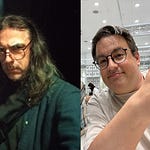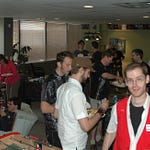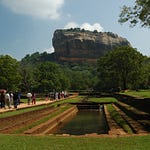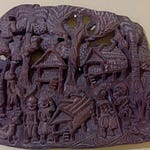Listen to Part 1 of this interview.
Welcome to Part 2 of my wide-ranging conversation with my dear friend Kaj Arnö in Nagu, Finland, in the Finnish Archipelago. For those who don't know Kaj, Kaj was one of the Finnish contingent of leaders at MySQL AB that shepherded the open source database to becoming the world's most popular before being sold to Sun Microsystems in 2008. He is one of the founders of MariaDB, former CEO, and now executive chairman of the MariaDB Foundation. To know more about all these things, please listen to last week's episode.
Kaj and I became friends because of our love of the outdoors. Kaj spends much of the summer, when he can, in Nagu and on the islands there by boat and kayak. I have written about the joy of spending Midsummer in these islands and even a kayaking trip to one of the more famous islands called Jurmo. This area is primarily inhabited by the Swedish-speaking minority of Finland and is therefore the subject of this episode.
Please note, as with the previous episode, we recorded this live in Nagu while walking and playing with Kaj's young son. As such, you will hear wind noise and the sounds of frisbees and a football.
Today, however, let's start with a poem by Finland's National Poet, J. L. Runeberg, first in Swedish, then in English. This poem talks about the birds that fly north to summer in the Finnish Archipelago.
Project Frederika and the Soul of Swedish Finland: A Conversation with Kaj Arnö (Part 2)
Our conversation then turned to a new passion project: using open data to preserve the rich history of Swedish-speaking Finland in the age of AI.
Dups: Now, Kaj, you are involved in something called Project Frederika. First of all, what is Project Frederika?
Kaj: Project Frederika is about making Swedish Finland better represented on open data, meaning Wikipedia and Wikidata. It's also part of the general mission of making objective fact more used by humanity.
We know that there's a bias in LLMs. They can be sexist and racist in several ways because they are trained on data that is sexist and racist. This is a way to change it. The way you change it is by ensuring that the data on which the large language models (LLMs) are centrally trained—namely Wikipedia—has correct information. That is the goal of Project Frederika. Yes, we start from the luxurious, quote-unquote, problem of Swedish Finland, but the general case is a much more important one: to ensure that the base data out there is correct and unbiased.
Dups: That is really important. In a previous episode, I talked about the case of the "disappearing internet," but also how bias is entering so much of our reference material like Wikipedia, and therefore we're actually changing our own past. How do you ensure the accuracy or "correctness" of the information? Aren't you just as biased as everybody else?
Kaj: I think that's a valid question. My answer is that I don't need to provide the mechanism for accuracy; it's already provided by the design of Wikipedia. Wikipedia has a peer-review mechanism where others are checking the validity of data, and that's a functioning model.
What is broken, though, is that the amount of interest going into certain areas is not representative of the overall interest of humankind. For example, computer games happen to interest young males, and these young males are writing a lot about them on Wikipedia, which means that data is over-represented. That is an issue I noted for Swedish Finland. Here in Nagu, I inherited five paintings from two semi-famous artists, Johan Knutson and Dora Wahlroos. I didn't know about them, so I thought, "Well, I need to check Wikipedia." They only had articles in Finnish, although they were Swedish-speaking. I thought that must not remain the case. Somebody ought to do something.
At the same time, I realized that if that "somebody" is to ever appear, I have a special responsibility to take on that role because I share an interest in both openness and Swedish Finland. And through my work with MySQL and now MariaDB, I've been in close contact with the infrastructure people at the Wikimedia Foundation, because Wikipedia ran on MySQL and has been running on MariaDB for many years. So I had both the technical opportunity and the personal interest to make this happen.
Dups: This archipelago that we're sitting in is how many islands?
Kaj: We're now in Nagu. Nagu has about 1,400 to 1,500 inhabitants and way more than 3,000 islands. And if you look at Wikipedia, I think there were 1,212 articles on different islands in the Nagu archipelago.
Dups: As I understand it, the Swedish-Finnish archipelago in this area has had an outsized influence in the world. I believe seafarers from here went all around the world?
Kaj: Yes, there's an extraordinary influence from this area just because of the geography. If you look at Jared Diamond and his book Guns, Germs, and Steel, he says that geography has an influence. People are just as smart or as diligent, as good and as bad everywhere, but geography influences things. This is very much the case in the archipelago here. We who live here have been the interface between the outside world and Finland since time immemorial. You had to pass through here; the archipelago was the road.
That means we became experts on logistics and travel by sea. For instance, if you take the Russian conquest of Alaska, the Russians themselves were not seafarers and didn't have naval officers to the extent that the Germans in the Baltics and the Swedes in Finland did. The knowledge we have here about how to build boats and how to sail was what made the traffic from St. Petersburg to Alaska possible. It turns out that two of the governors of Russian Alaska came from this group of people speaking Swedish in Finland.
I've been to Alaska and I went to what's now called Sitka; it was called Novo-Arkhangelsk by the Russians. You have buildings there where Americans say, "Oh, don't you see this Russian architecture?" Well, no, it is Nagu architecture, or specifically it's Åland architecture. The houses look like what the seamen built at home on Åland, and they built the same type of houses when they came to Sitka.
Dups: For a lot of listeners, they won't know the difference between Swedish-speaking Finland and Sweden. Swedish-speaking Finns are very much Finnish, and you do not see yourselves as Swedes from Sweden. Why is that?
Kaj: Correct. Sweden and Finland were one country until we were attacked by Russia in 1808-1809. There was a war of conquest where Russia conquered the eastern part of Sweden, which is today's Finland. At that point, about one person in five in Finland spoke Swedish. It’s not like the Baltics, where the ruling class was German and the peasants were Estonian or Latvian. Oh yes, the ruling class in Finland was Swedish-speaking, but the general population along the coast—all classes of society—was also Swedish-speaking.
After 1809, everything continued in Swedish from an administrative perspective until the 1860s when the Finnish language started to grow in prominence. Ever since, Swedish has been an integral part of Finland. So yes, we have ancestry from Sweden from hundreds of years ago—our ancestors immigrated to Finland around the 1200s. But if you have been living in a different place for 800 years, you are not associated with that mother country. Look at Americans—are they associated with the UK? And that's a question of the last two or three hundred years.
One thing you should know about Swedish-speaking Finns (finlandssvenskar) is that our association in sports is always with Finland. We will always cheer for Finland. There's no chance that anyone, even those who don't know any Finnish, would cheer for Sweden against Finland.
Dups: Are there any unique words or foods from the finlandssvenska culture or the archipelago that are very different from in Sweden?
Kaj: Yes. For instance, haru. One of the island types close to us in the outer archipelago is called Gråharu. Even the fact that you pronounce it with short vowels, haru, is something they don't do in Sweden. So yes, we definitely have different words.
As for food, gravad lax (cured salmon) is one that everybody knows. Then we have what Swedes call skarpsill, which we call vassbuk. It's a small fish, about 10 centimeters long, and it's super delicious. There are various ways of preparing it, and it's a typical dish here in the Nagu archipelago.
Dups: You've mentioned Åland a couple of times. Now, Åland is very interesting because it is neither Finnish nor Swedish, in a way. It was established before the United Nations, correct?
Kaj: Correct. The predecessor of the United Nations, the League of Nations, ruled in 1921 that Åland was to be part of Finland, not Sweden. Why did that question even pop up? Because when Russia occupied Finland in 1809, Åland was part of the territory. After World War I, many people on Åland wanted to be part of Sweden because they don't speak Finnish there and are culturally very much associated with Sweden.
But the League of Nations, based on a plea from Finland, made the decision that Åland should be part of Finland, but be autonomous and monolingually Swedish. It was also demilitarized as a result of the Crimean War in the 1850s. This was confirmed by the League of Nations—Finland was not supposed to have any military presence on Åland in peacetime. That, of course, changed when peace was no longer there. During World War II, my father was on the frontlines on Hammarland in Åland.
And that demilitarized status is interesting today. Russia has closed all its consulates in Finland in other cities except for one place: the capital of Åland, Mariehamn.
Dups: If someone wanted to find out more about Project Frederika, how would they do that?
Kaj: They can go to our website, which is projektfrederika.fi, or through our Wikipedia project page, which is also called Project Frederika.
Dups: The project is named after Fredrika Runeberg, wife of the famous poet J. L. Runeberg.
Kaj: Yes. But she was not just a token wife. She was also Finland's first female journalist and a writer in her own right. That is why we decided for our project to pick a name which is not yet another man, but somebody who created value for humanity despite her gender, at a time when that was not the usual thing.
Dups: Thank you again for coming on the show at Tales Under the Cat Tree and talking about Project Frederika. I learned a lot, and I'm sure lots of other people did too.
Kaj: My pleasure. I was super happy to get the opportunity. I could talk about these things for ages.













